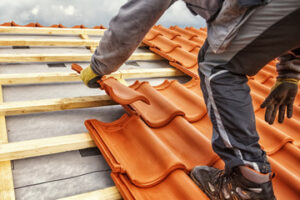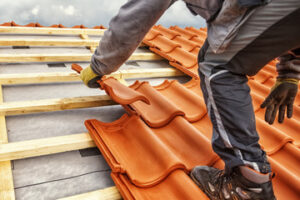Your roof does a lot for you daily, absorbing harsh sun rays and temperamental weather while playing a key role in your building’s insulation and ventilation.

Performing regular maintenance and inspections can help prevent problems and catch them early. These include inspecting the field of the roof for signs of wear and tear, trimming trees that overhang the roof, and ensuring that seals around skylights, chimneys, and vents are intact. Contact Corpus Christi Roofing CO for professional help.
A professional roof inspection will check your entire roof system, including the gutters, chimneys, skylights, vent pipes, and shingles. They will also look at the fascia boards and soffit boards to ensure that they are in good condition. The inspector will also inspect the interior of your attic to make sure that it is adequately ventilated and free of water stains or other signs of leaks.
When it comes to examining the roof itself, an inspector will start with a walk around from the ground. They will carefully check for shingle granule loss, which is a sign of hail damage. They will also look for shingle curling or splitting, as well as dents in the shingles. If the shingles are damaged, it will be necessary to have them replaced.
After the initial walk around, the inspector will get on a ladder to examine the roof itself. They will check the soffit and fascia boards for any rot, cracking, warping or other signs of damage. They will then look for rust in the thin metal flashing that lines penetrations like skylights and chimneys. This is where a lot of roof leaks originate, so it is essential that these areas are properly flashed.
They will then examine the ridge vents, gable vents, and attic vents to make sure that they are all in good condition and that they are not blocked or clogged. These vents help to keep your home cool and regulate humidity.
Next, the inspector will examine the rafters and joists for any signs of rot or other structural damage. They will also check for any areas that appear to be sagging, as this is a sign of a failing roof system and should be repaired immediately.
The inspector will also take the opportunity to check the gutters and downspouts for any damage, especially in the corners where they meet the roof. Gutters that aren’t functioning properly can cause water to seep into the roof, which is very bad for shingles and other roofing materials. They will also check for any clogs in the downspouts that could prevent them from draining.
Inspect the Gutters
Gutters perform a vital function that protects the foundation and other structures of the home from water damage. But like any other roofing component, they can deteriorate over time if they aren’t inspected and maintained.
If a gutter becomes damaged, it can force water into concealed cornice and roof areas and cause major problems. This can lead to basement flooding, water damage to the structure of the home, siding damage and landscaping problems. Fortunately, regular inspections and preventive maintenance can help to identify and repair issues before they become serious.
When performing a visual inspection of your gutters, start by clearing out any debris that has collected in them. Use a ladder to scoop out the larger debris and place it in a bucket attached to your ladder or on the ground for later disposal. Once the debris is removed, look for clogs or other signs of wear and tear.
You should also check for visible cracks and rust. These are a sign that your gutters are starting to break down and may need to be replaced. Another sign to look for is if your gutters are pulling away from the roofline. This is a common issue that can be caused by high winds or heavy rain, and it’s important to have this problem addressed as soon as possible to prevent further damage.
Once you’ve examined the gutters for any visible signs of damage, turn on a garden hose and run water along the highest parts of the gutter system. If you can see water leaking through the gutters, this is an indication that the sealant on the gutters has failed and needs to be replaced. If the sealant is still in good condition, however, then it’s likely that the gutters are simply clogged and need to be cleaned out.
If your gutters are leaking, it’s a good idea to hire a professional to have them repaired as soon as possible. If you wait too long, the leaks can result in significant water damage to your home’s structure and interior. In addition to repairing the leaky gutters, you should also make sure that any roof penetrations such as skylights and vents are properly sealed.
Inspect the Flashing
A home’s flashing is a critical component designed to prevent water leaks in vulnerable areas such as chimneys, skylights and the joints where roof sections meet vertical surfaces like walls. In addition to directing water away from these areas, the flashing also creates a sealant barrier preventing rainwater and moisture from entering the structure. Inspecting and replacing the caulk in these areas on a regular basis is important to help keep water damage from occurring within the home.
A rusty or corroded surface, exposed nails, loose pieces and dents are all signs of flashing damage and should be addressed as soon as possible. This can save a homeowner from costly roof repair later on. The longer a homeowner waits to replace the flashing, the more serious the issue may become.
When inspecting the flashing, homeowners should also look for cracks or splits in the lead surface. These can occur due to severe weather conditions, improper installation or age. The flashing should be firmly anchored and sealed at all vulnerable areas including the points where different roof components meet, valleys, chimneys and dormer windows.
Leaks during and after a rainstorm or dripping in the attic are other indicators of a problem with the flashing. These should be repaired immediately as they can lead to major problems in the roofing system and interior of the home.
It is a good idea for homeowners to perform a self-inspection in between professional roof inspections to gauge the condition of their home’s flashing. This can be done by safely climbing on the roof and checking all securely anchored areas. This should be done with the proper safety equipment such as a fall protection harness or rope, non-slip shoes and gloves.
Chimneys and skylights are common places where flashing is installed because they penetrate the roof surface. In addition, the flashing should be inspected in all safely accessible areas including valleys and junctions where two roof slopes converge and the points where a wall or dormer meets the roof. This can be difficult to see and may require a professional to examine and assess the damage.
Inspect the Skylights
Skylights are a beautiful addition to any home, flooding interiors with natural light and creating a warm and welcoming atmosphere. However, like any other roof feature, they can be susceptible to leaks and water damage if not properly maintained. The first step to preventing problems is conducting regular inspections of the shingles, flashing, and skylight frame. Promptly addressing any concerns will prevent water infiltration and ensure the integrity of the structure.
The most common cause of skylight leaks is damage to the flashing or seal. This can occur due to normal wear and tear or from weather elements such as hail and rain. In order to avoid this, homeowners should regularly inspect their skylights and re-caulk any areas that show signs of wear and tear or leaking.
Depending on the type of skylight, homeowners should also check for rust, corrosion, and other structural damage to the sash and glass. In addition, it is a good idea to clear away any debris from around the skylight including clogged gutters and overhanging branches. Regular maintenance of roof penetrations such as chimneys, skylights, vents and projections can be a great way to save money on heating and cooling bills as well as prevent the formation of ice dams during winter.
Leaks in a skylight can be difficult to spot because they are often hidden from view by the ceiling and walls, but they can lead to serious mold growth, which can affect the health of those in the home as well as their property value. Signs of a leaky skylight include discolored spots on the ceiling or wall, water spots, and mold growth. These signs can be detected by a homeowner simply looking at the affected area on a sunny day or by a professional roof inspector during a routine inspection.
As part of any roofing maintenance, a professional roofer should also inspect any roof penetrations such as chimneys, skylights, and vents for damage or leaking. It is a good idea to also perform regular maintenance of these features such as clearing away creosote build-up on chimneys and ensuring that all vents remain unobstructed.

